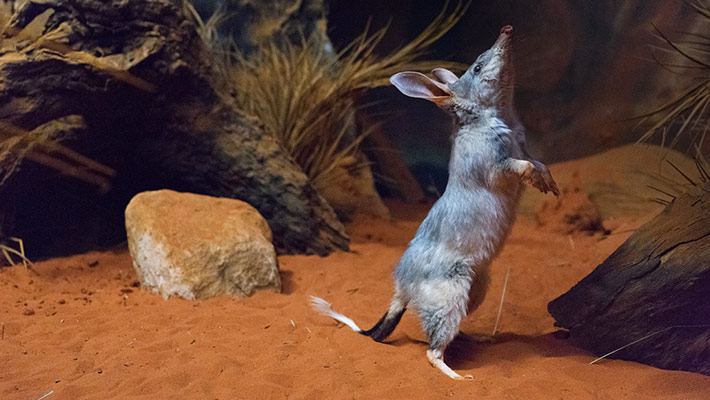Burrow bandits
Bilbies are the largest species in the bandicoot family and have beautiful fluffy, silky grey fur and a long snout with a slender tongue. With such a delicate appearance one is led to wonder how such an animal could ever survive such harsh desert conditions! They keep cool in the hot Australian summer by using their strong claws to dig cool burrows underground. These burrows are generally spiral and as much as 3 meters long and 1.8m deep.
Twisting an ear
Their large, hairless ears let heat from their body escape and they emerge to find food in the cool of the night. They have amazing smell and hearing which is important for finding food and detecting predators from far away. Their ears are exceptionally maneuverable and can be rotated, made to stand flat against the body, positioned at right angles to the body and can even be folded in half.
A backwards pouch?
Bilbies are marsupials, meaning they give birth to live young at a very early stage of their development and the young develop while attached to a teat in a pouch on the outside of the females' body. Bilbies are even more unusual because they have a backwards facing pouch! This is a very useful adaptation because it means that when a female is digging away at the soil to hunt for food or build a burrow, the soil does not fill up in the pouch.
Ecological engineers
Bilbies are a very important ‘ecological engineers’ in the iconic Australian bush. They create disturbances in the form of nose pokes, scratching, shallow and deep digs, long bull-dozing tracts and complex subterranean burrows. They might be small, but these mammals punch above their weight, shifting up to 3.6 tonnes of soil per kilogram of body mass in a year! In doing this, they improve the soil health by turning over and mixing organic matter. Soil turnover brings deep soils and their nutrients to the surface. Their diggings also trap organic matter and other materials, increasing nutrient availability to the plants.
Threats in the wild
The main threats to their survival are loss of habitat, competition with introduced species and predation, particularly by cats and foxes. Rabbits, cattle and other hoofed mammals compete with bilbies for food and habitat, as agricultural activities now extend over most of Australia’s fertile regions, with tree clearing, crop planting and domestic stock grazing making these areas unsuitable for bilbies.

Bouncing Back
The Greater Bilby is one of Taronga’s Legacy Species and we are committed to returning bilbies to NSW and supporting their recovery nationally. Their future is looking brighter thanks to the establishment of a free ranging population of bilbies within a 110ha feral predator free Sanctuary at Taronga Western Plains Zoo in Dubbo. In 2020, ten bilbies bred in Dubbo were released into Sturt National Park in north-eastern NSW as part of the UNSW Wild Deserts program. This reintroduction comes more than 100 years after the bilby was declared extinct in NSW. This population has boomed to 60 individuals as of early 2022. In June 2022, 32 bilbies were translocated from the Taronga Western Plains Zoo Sanctuary into the Australian Wildlife Conservancy’s Newhaven Wildlife Sanctuary in Central NT. Taronga is continuing to breed bilbies in our Sanctuary to support reintroduction and conservation efforts across Australia.
Come and meet us
The Greater Bilby can be seen at Taronga Zoo Sydney in Nguwing Nura - Nocturnal Country.